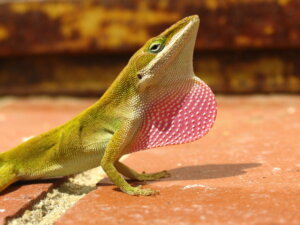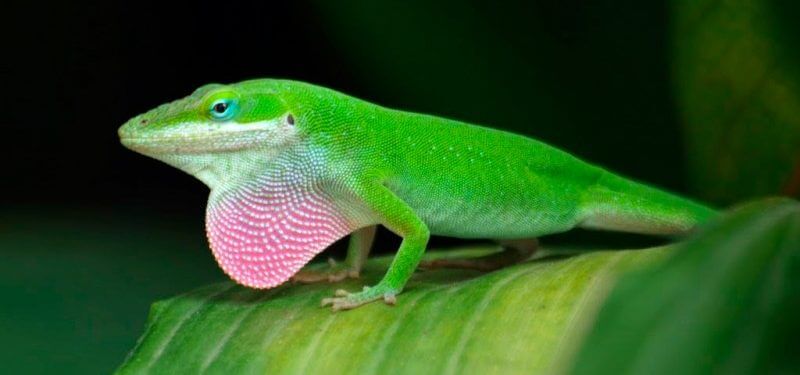The Anolis: Habitat, Characteristics and Reproduction


Written and verified by the veterinarian and zootechnician Sebastian Ramirez Ocampo
Endemic to the American continent, the anolis is a dactylic scaly reptile whose name comes from the French l’anole, a term used by the Caribbean Indians to refer to the lizards of the Lesser Antilles.
Although some of the 437 existing anole species can change their body color, their physical characteristics are very different from those of chameleons. In fact, these small lizards are more closely related to iguanas.
Their main characteristic, as mentioned above, is the ability of anoles to change their body color. According to the article “Transcriptomic Analysis of Skin Color in Anole Lizards“, these lizards can make chromatic changes according to the temperature of the environment, their mood, or the environment in which they find themselves. However, this isn’t the only thing that makes them so particular. Continue reading and learn everything about this group of animals.
Physical characteristics of the anolis
They usually reach sizes of up to 20 centimeters (8 inches) long and weights of 8 grams (0.3 oz). Their body is slender and flattened and they’re found in green, brown, gray, and brown colors. They have five clawed toes on their forelimbs and four on their hind limbs. Thanks to this, the anolis can easily climb trees in their habitat, as they are arboreal.
On the other hand, they have round and granular scales that cover their head, body, belly, and limbs. In this species of lizard, there is a clear sexual dimorphism, with the male being the one that is larger in adulthood.
Similarly, the male differs from the female by having a kind of sac or dewlap on the lower part of its neck. This structure, which is usually red or pink, is used to attract females or to compete with other lizards for territory.

Habitat and diet
Arboreal and diurnal, anolis inhabit the various forests and grasslands of North and South America, although they can be found in the territories of Hawaii, Japan, and the West Indies. Although they have a preference for environments with abundant vegetation such as the Amazon, in recent years they have been found in cities as a result of the reduction of their natural habitat.
They feed on insects such as flies, spiders, butterflies and beetles, which they hunt by stealth as they camouflage themselves with their surroundings. They may also include certain seeds in their diet when prey isn’t available.
Reproduction of anoles
Anoles generally reach maturity at eight months of age. Reproduction is sexual and oviparous. The gestation period usually lasts one to two weeks, ending when the female deposits her eggs in the soil.
The female can lay up to 6 eggs, which take 5 to 6 weeks to incubate. This process can be repeated three to four times in a year in the warm months of May to September.

Curiosities
In the Amazon, finding an anolis is a symbol of good luck and prosperity. However, if you harm or kill it, you will bring the opposite, as it’s considered a bad omen. On the other hand, males are so territorial that if you put them in front of a mirror, they’ll try to fight against their reflection.
Another curious fact about these lizards is that females can store the male’s sperm, waiting for the ideal occasion during ovulation. Likewise, the anolis has adhesive structures on its limbs that allow it to climb walls and vertical structures with ease. Finally, like other lizards, it is capable of losing its tail and then regenerating it.
Endemic to the American continent, the anolis is a dactylic scaly reptile whose name comes from the French l’anole, a term used by the Caribbean Indians to refer to the lizards of the Lesser Antilles.
Although some of the 437 existing anole species can change their body color, their physical characteristics are very different from those of chameleons. In fact, these small lizards are more closely related to iguanas.
Their main characteristic, as mentioned above, is the ability of anoles to change their body color. According to the article “Transcriptomic Analysis of Skin Color in Anole Lizards“, these lizards can make chromatic changes according to the temperature of the environment, their mood, or the environment in which they find themselves. However, this isn’t the only thing that makes them so particular. Continue reading and learn everything about this group of animals.
Physical characteristics of the anolis
They usually reach sizes of up to 20 centimeters (8 inches) long and weights of 8 grams (0.3 oz). Their body is slender and flattened and they’re found in green, brown, gray, and brown colors. They have five clawed toes on their forelimbs and four on their hind limbs. Thanks to this, the anolis can easily climb trees in their habitat, as they are arboreal.
On the other hand, they have round and granular scales that cover their head, body, belly, and limbs. In this species of lizard, there is a clear sexual dimorphism, with the male being the one that is larger in adulthood.
Similarly, the male differs from the female by having a kind of sac or dewlap on the lower part of its neck. This structure, which is usually red or pink, is used to attract females or to compete with other lizards for territory.

Habitat and diet
Arboreal and diurnal, anolis inhabit the various forests and grasslands of North and South America, although they can be found in the territories of Hawaii, Japan, and the West Indies. Although they have a preference for environments with abundant vegetation such as the Amazon, in recent years they have been found in cities as a result of the reduction of their natural habitat.
They feed on insects such as flies, spiders, butterflies and beetles, which they hunt by stealth as they camouflage themselves with their surroundings. They may also include certain seeds in their diet when prey isn’t available.
Reproduction of anoles
Anoles generally reach maturity at eight months of age. Reproduction is sexual and oviparous. The gestation period usually lasts one to two weeks, ending when the female deposits her eggs in the soil.
The female can lay up to 6 eggs, which take 5 to 6 weeks to incubate. This process can be repeated three to four times in a year in the warm months of May to September.

Curiosities
In the Amazon, finding an anolis is a symbol of good luck and prosperity. However, if you harm or kill it, you will bring the opposite, as it’s considered a bad omen. On the other hand, males are so territorial that if you put them in front of a mirror, they’ll try to fight against their reflection.
Another curious fact about these lizards is that females can store the male’s sperm, waiting for the ideal occasion during ovulation. Likewise, the anolis has adhesive structures on its limbs that allow it to climb walls and vertical structures with ease. Finally, like other lizards, it is capable of losing its tail and then regenerating it.
All cited sources were thoroughly reviewed by our team to ensure their quality, reliability, currency, and validity. The bibliography of this article was considered reliable and of academic or scientific accuracy.
- Ayala-Varela F, Valverde S, Poe S, Narváez AE, Yánez-Muñoz MH, Torres-Carvajal O. A new giant anole (Squamata: Iguanidae: Dactyloinae) from southwestern Ecuador. Zootaxa. 2021;4991(2):295-317.
- de Mello PLH, Hime PM. Transcriptomic Analysis of Skin Color in Anole Lizards. 2021;13(7).
- Husak JF, Rohlf CM, Lailvaux SP. Immune activation affects whole-organism performance in male but not female green anole lizards (Anolis carolinensis). Journal of comparative physiology B, Biochemical, systemic, and environmental physiology. 2021;191(5):895-905.
- Lovern MB, Holmes MM, Wade J. The green anole (Anolis carolinensis): a reptilian model for laboratory studies of reproductive morphology and behavior. ILAR journal. 2004;45(1):54-64.
This text is provided for informational purposes only and does not replace consultation with a professional. If in doubt, consult your specialist.








